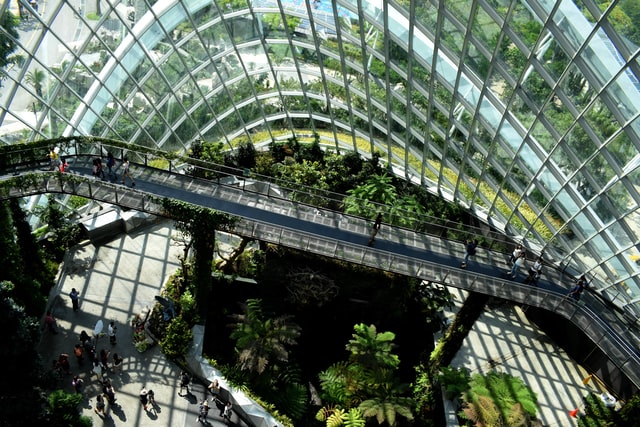3 Aug. 2023

Our last two blogs dove into Carbon Credits, explaining both the terms and basics as well as how you can incorporate them into your business plan.
Read our first Carbon Credit blog here: https://www.setpoint.ai/blog_post/carbon-credits-what-are-they/
And our second Carbon Credit blog here: https://www.setpoint.ai/blog_post/incorporating-carbon-credits-into-your-business-plan/
With this last blog in the Carbon Credits series, we want to dive into other sustainable technologies to invest in, to get ahead of the game.
The trading of Carbon Credits allows companies and the world to meet progressive goals for reducing greenhouse-gas emissions. Individuals or companies looking to offset their own greenhouse gas emissions can buy Carbon Credits through specific environmental projects or instead, create a sustainable strategy to guide their climate journey by investing in other sustainable technologies.
With that being said, these are the top 5 technologies your business should invest in to see how you can start major reductions on your utility bills
The term “Net-Zero Energy” refers to when the total yearly consumption is less than or equal to the amount of on-site energy created using innovative technology and renewable power generation.
Net-zero energy design is a predominant concept gaining momentum in design and construction globally. This ranges from basic material use such as solar panels, fuel cells, or biofuels to meet the electricity requirement of a building.
Achieving net-zero consumption permits no energy waste, and considerably reduces carbon footprints as the buildings can put power back on the grid if necessary. This creates immense benefits ranging from cost savings on utility bills for tenants (due to the increased energy efficiency), lower construction costs, as well as a higher property value for building developers, and increased occupancy rates for building owners. In commercial buildings, this is crucial in developing a sustainable and profitable business strategy. Building owners are also more prone to meet city or government regulations on carbon emissions, therefore eliminating the need to buy Carbon Credits.
According to McKinsey, most of the environmental impact associated with the consumer sector is embedded in supply chains, accounting for more than 80% of greenhouse-gas emissions and more than 90% of the impact on air, land, water, biodiversity, and geological resources” (McKinsey).
Predictive Maintenance is a way to predict energy consumption patterns, making it incredibly beneficial to utility companies, users, and facility managers because it can help to improve energy efficiency.
Technologies such as Predictive Maintenance and building automation can create personalized control as well as prevent unnecessary repairs. Machine Learning creates automation that can monitor performance, controls building equipment, and allows for remote scheduling of a facility’s capabilities. Building automation’s ultimate goal is to achieve complete autonomous control of an entire facility.
Data is necessary for understanding a building’s energy consumption.
IoT-enabled smart building platforms that are wired with connected systems provide usage insights to improve energy efficiency. Data from smart building platforms permits building operators to make smart and informed decisions on how to create better energy outcomes for their commercial buildings.
IoT platforms deliver the necessary energy-consumption analytics on use as well as overuse, as well as the indicators of where adjustments are needed to save energy.
According to the American Council for an Energy-Efficient Economy (ACEEE), “Commercial buildings could save up to $60 billion if investments in energy efficiency were increased by just one to four percent.”
With increased pressures from institutions to go carbon neutral, companies must find ways to decrease carbon emissions with the goal of Net-Zero Carbon emissions.
Buildings are one of the largest producers of carbon emissions in the world throughout their construction and operations, and it can be difficult to find ways to reduce and even eliminate the use of carbon in buildings.
Whether it’s the use of on-site solar energy, or an integrated control system including HVAC, efficient lighting, or dimmable windows, green energy is the way to go.
Plus, green energy is an amazing alternative in terms of construction and infrastructure.
Buildings can achieve near-zero carbon performance by eliminating fossil fuel use for heating, lessening the use of high global warming potential refrigerants, or using low-carbon, reused or recycled materials in construction.
“Global building floorspace is projected to double by 2060 and only 3% of investment in new construction is green and efficient, locking in high emissions for decades. The renovation rate for existing buildings is barely 1%, less than a third of the rate needed to meet the Paris climate goals,” says We Forum
Selecting carbon-conscious partners for building implementation can lead to lower carbon emissions and can help companies and organizations reach carbon neutrality goals.
By implementing green energy strategies to reduce carbon emissions, companies can maximize the benefits of contributing to a healthier environment while creating more sustainable and profitable business operations.
IT Operations Automation is the new solution to reduce workloads. Its top benefits include efficiency, reliability, flexibility, and productivity.
To properly manage and optimize complex environments, IT organizations are using artificial intelligence to identify setbacks, delays, and failures before they occur. These include methods such as alert processing and notification systems that save time by preventing repairs from having to occur.
Built-in Reporting features also allow employees to track project timelines, alert frequencies, or any number of necessary pieces of information.
The goal of workload automation is to get more things done, operate at a faster pace, and do that in a highly successful and resilient way.
Technology startups are trying to bring new and innovative ideas to the carbon-offset market as more companies seek to compensate for their greenhouse-gas emissions.
Reducing energy consumption will earn the company Carbon Credits, which are tradable assets that can bring in a substantial amount of money to the company. However, it’s still crucial to stay on top of the best smart technology investments to boost sustainability.
Learn more about Sepoint’s Climate Intelligence solution here: https://www.setpoint.ai